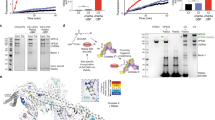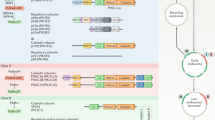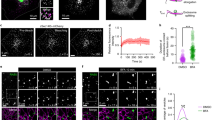Abstract
Protein kinase D (PKD) regulates the fission of vesicles originating from the trans-Golgi network1,2. We show that phosphatidylinositol 4-kinase IIIβ (PI4KIIIβ) — a key player in the structure and function of the Golgi complex3 — is a physiological substrate of PKD. Of the three PKD isoforms, only PKD1 and PKD2 phosphorylated PI4KIIIβ at a motif that is highly conserved from yeast to humans. PKD-mediated phosphorylation stimulated lipid kinase activity of PI4KIIIβ and enhanced vesicular stomatitis virus G-protein transport to the plasma membrane. The identification of PI4KIIIβ as one of the PKD substrates should help to reveal the molecular events that enable transport-carrier formation.
This is a preview of subscription content, access via your institution
Access options
Subscribe to this journal
Receive 12 print issues and online access
$209.00 per year
only $17.42 per issue
Buy this article
- Purchase on Springer Link
- Instant access to full article PDF
Prices may be subject to local taxes which are calculated during checkout




Similar content being viewed by others
References
Liljedahl, M. et al. Protein kinase D regulates the fission of cell surface destined transport carriers from the trans-Golgi network. Cell 104, 409–420 (2001).
Yeaman, C. et al. Protein kinase D regulates basolateral membrane protein exit from trans-Golgi network. Nature Cell Biol. 6, 106–112 (2004).
Godi, A. et al. ARF mediates recruitment of PtdIns-4-OH kinase-β and stimulates synthesis of PtdIns(4,5)P2 on the Golgi complex. Nature Cell Biol. 1, 280–287 (1999).
Rykx, A. et al. Protein kinase D: a family affair. FEBS Lett. 546, 81–86 (2003).
Prestle, J., Pfizenmaier, K., Brenner, J. & Johannes, F. J. Protein kinase Cμ is located at the Golgi compartment. J. Cell Biol. 134, 1401–1410 (1996).
Maeda, Y., Beznoussenko, G. V., Van Lint, J., Mironov, A. A. & Malhotra, V. Recruitment of protein kinase D to the trans-Golgi network via the first cysteine-rich domain. EMBO J. 20, 5982–5990 (2001).
Baron, C. L. & Malhotra, V. Role of diacylglycerol in PKD recruitment to the TGN and protein transport to the plasma membrane. Science 295, 325–328 (2002).
Jamora, C. et al. Gβγ-mediated regulation of Golgi organization is through the direct activation of protein kinase D. Cell 98, 59–68 (1999).
Anel, A. M. & Malhotra, V. PKCη is required for β1γ2/β3γ2- and PKD-mediated transport to the cell surface and the organization of the Golgi apparatus. J. Cell Biol. 169, 83–91 (2005).
Hausser, A. et al. Structural requirements for localization and activation of protein kinase Cμ (PKCμ) at the Golgi compartment. J. Cell Biol. 156, 65–74 (2002).
Waldron, R. T. et al. Activation loop Ser 744 and Ser 748 in protein kinase D are transphosphorylated in vivo. J. Biol. Chem. 276, 32606–32615 (2001).
Walch-Solimena, C. & Novick, P. The yeast phosphatidylinositol-4-OH kinase pik1 regulates secretion at the Golgi. Nature Cell Biol. 1, 523–525 (1999).
Sciorra, V. A. et al. Synthetic genetic array analysis of the PtdIns 4-kinase Pik1p identifies components in a Golgi-specific Ypt31/rab-GTPase signaling pathway. Mol. Biol. Cell 16, 776–793 (2005).
Wang, Y. J. et al. Phosphatidylinositol 4 phosphate regulates targeting of clathrin adaptor AP-1 complexes to the Golgi. Cell 114, 299–310 (2003).
Nakagawa, T., Goto, K. & Kondo, H. Cloning, expression, and localization of 230-kDa phosphatidylinositol 4-kinase. J. Biol. Chem. 271, 12088–12094 (1996).
Godi, A. et al. FAPPs control Golgi-to-cell-surface membrane traffic by binding to ARF and PtdIns(4)P. Nature Cell Biol. 6, 393–404 (2004).
Doppler, H., Storz, P., Li, J., Comb, M. J. & Toker, A. A phosphorylation state-specific antibody recognizes HSP27, a novel substrate of protein kinase D. J. Biol. Chem. 280, 15013–15019 (2005).
Nishikawa, K., Toker, A., Johannes, F. J., Songyang, Z. & Cantley, L. C. Determination of the specific substrate sequence motifs of protein kinase C isozymes. J. Biol. Chem. 272, 952–960 (1997).
Hutti, J. E. et al. A rapid method for determining protein kinase phosphorylation specificity. Nature Methods 1, 27–29 (2004).
Prigozhina, N. L. & Waterman-Storer, C. M. Protein kinase D-mediated anterograde membrane trafficking is required for fibroblast motility. Curr. Biol. 14, 88–98 (2004).
Suer, S., Sickmann, A., Meyer, H. E., Herberg, F. W. & Heilmeyer, L. M. Jr. Human phosphatidylinositol 4-kinase isoform PI4K92. Expression of the recombinant enzyme and determination of multiple phosphorylation sites. Eur. J. Biochem. 268, 2099–2106 (2001).
Iglesias, T. et al. Identification and cloning of Kidins220, a novel neuronal substrate of protein kinase D. J. Biol. Chem. 275, 40048–40056 (2000).
Arnold, R. et al. Activation of hematopoietic progenitor kinase 1 involves relocation, autophosphorylation, and transphosphorylation by protein kinase d1. Mol. Cell Biol. 25, 2364–2383 (2005).
Balla, A., Tuymetova, G., Tsiomenko, A., Varnai, P. & Balla, T. A plasma membrane pool of phosphatidylinositol 4-phosphate is generated by phosphatidylinositol 4-kinase type-III alpha: studies with the PH domains of the oxysterol binding protein and FAPP1. Mol. Biol. Cell 16, 1282–1295 (2005).
Storz, P., Doppler, H. & Toker, A. Protein kinase Cδ selectively regulates protein kinase D-dependent activation of NF-κB in oxidative stress signaling. Mol. Cell Biol. 24, 2614–2626 (2004).
Storz, P. & Toker, A. Protein kinase D mediates a stress-induced NF-κB activation and survival pathway. EMBO J. 22, 109–120 (2003).
Acknowledgements
We wish to thank L. Rameh for help with the lipid-kinase assay, and E. Behrle and O. Selchow for help with the confocal microscopy. This work was supported by grants from the Deutsche Forschungsgemeinschaft (SFB 495 to K.P.), the Landesstiftung Baden-Württemberg (to A.H.) and from the National Institutes of Health (CA075134 to A.T.).
Author information
Authors and Affiliations
Corresponding authors
Ethics declarations
Competing interests
The authors declare no competing financial interests.
Supplementary information
Supplementary Information
Supplementary figures S1 and S2 (PDF 84 kb)
Rights and permissions
About this article
Cite this article
Hausser, A., Storz, P., Märtens, S. et al. Protein kinase D regulates vesicular transport by phosphorylating and activating phosphatidylinositol-4 kinase IIIβ at the Golgi complex. Nat Cell Biol 7, 880–886 (2005). https://doi.org/10.1038/ncb1289
Received:
Accepted:
Published:
Issue Date:
DOI: https://doi.org/10.1038/ncb1289
This article is cited by
-
Beyond PI3Ks: targeting phosphoinositide kinases in disease
Nature Reviews Drug Discovery (2023)
-
Addressing the role of PKD3 in the T cell compartment with knockout mice
Cell Communication and Signaling (2022)
-
Phosphoinositides as membrane organizers
Nature Reviews Molecular Cell Biology (2022)
-
Diacylglycerol kinase and phospholipase D inhibitors alter the cellular lipidome and endosomal sorting towards the Golgi apparatus
Cellular and Molecular Life Sciences (2021)
-
Phosphatidylinositol 4-kinase IIIβ mediates contraction-induced GLUT4 translocation and shows its anti-diabetic action in cardiomyocytes
Cellular and Molecular Life Sciences (2021)



